Dissertation: Economic Consequences of Child Labour in 3 Nations
VerifiedAdded on 2020/10/22
|31
|10044
|309
Dissertation
AI Summary
This dissertation examines the economic consequences of child labour in India, Bangladesh, and Afghanistan, focusing on its impact on GDP, income inequality, and other macroeconomic factors. The study employs a deductive approach, drawing on secondary data from sources like UNICEF, and utilizes correlation and regression analysis to identify relationships between child labour rates and economic indicators. The research explores the prevalence of child labour in these nations, its effects on the labour market, and the resulting impact on national wealth and development. The findings highlight significant relationships between child labour and GDP growth, with a negative correlation observed in Bangladesh, a positive one in India, and a significant relationship in Afghanistan. The dissertation concludes with recommendations for addressing child labour through education and improved employment opportunities, emphasizing the need for policies that promote children's welfare and economic stability. The work includes a literature review, data analysis, and discussion of findings, providing insights into the complex relationship between child labour and economic development in the context of these three countries.
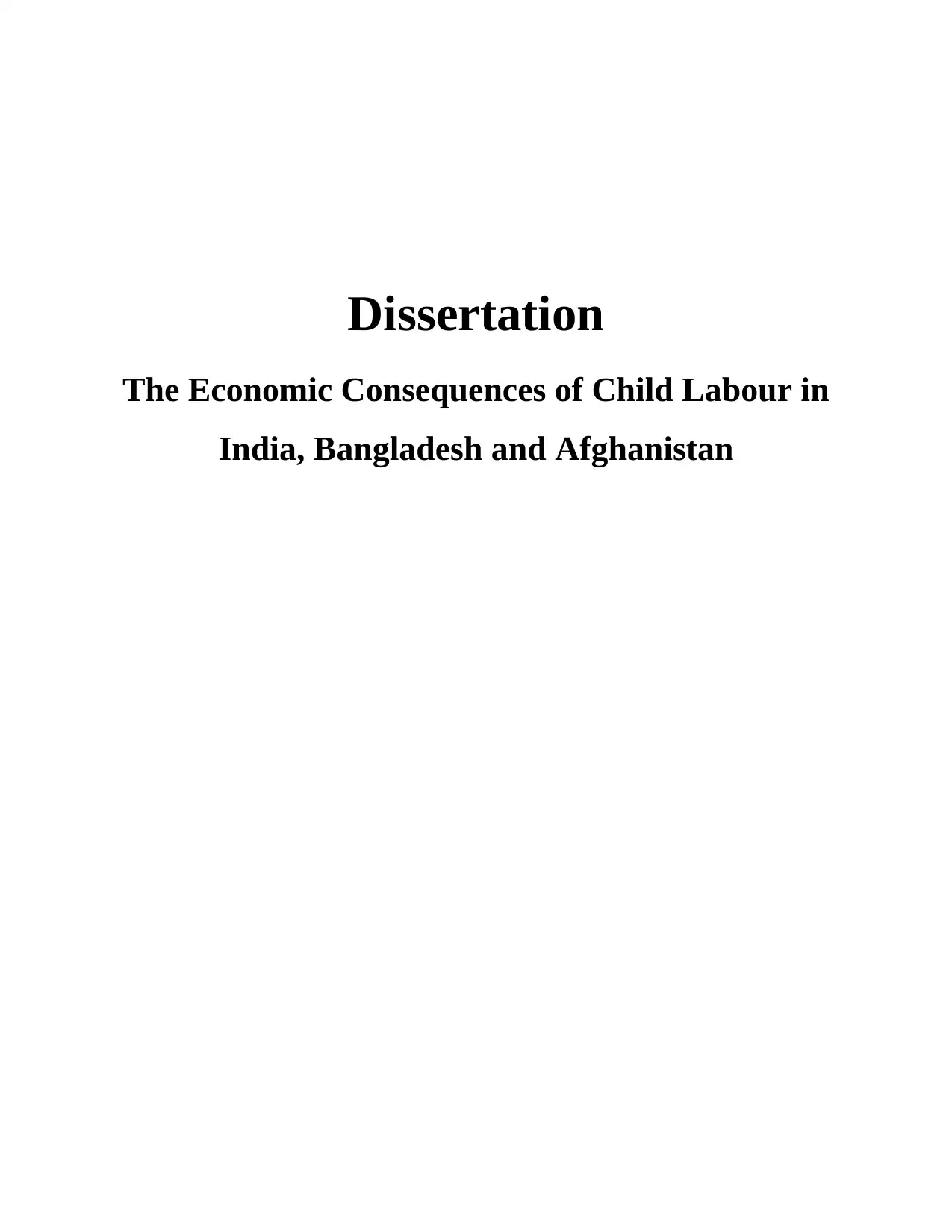
Dissertation
The Economic Consequences of Child Labour in
India, Bangladesh and Afghanistan
The Economic Consequences of Child Labour in
India, Bangladesh and Afghanistan
Paraphrase This Document
Need a fresh take? Get an instant paraphrase of this document with our AI Paraphraser
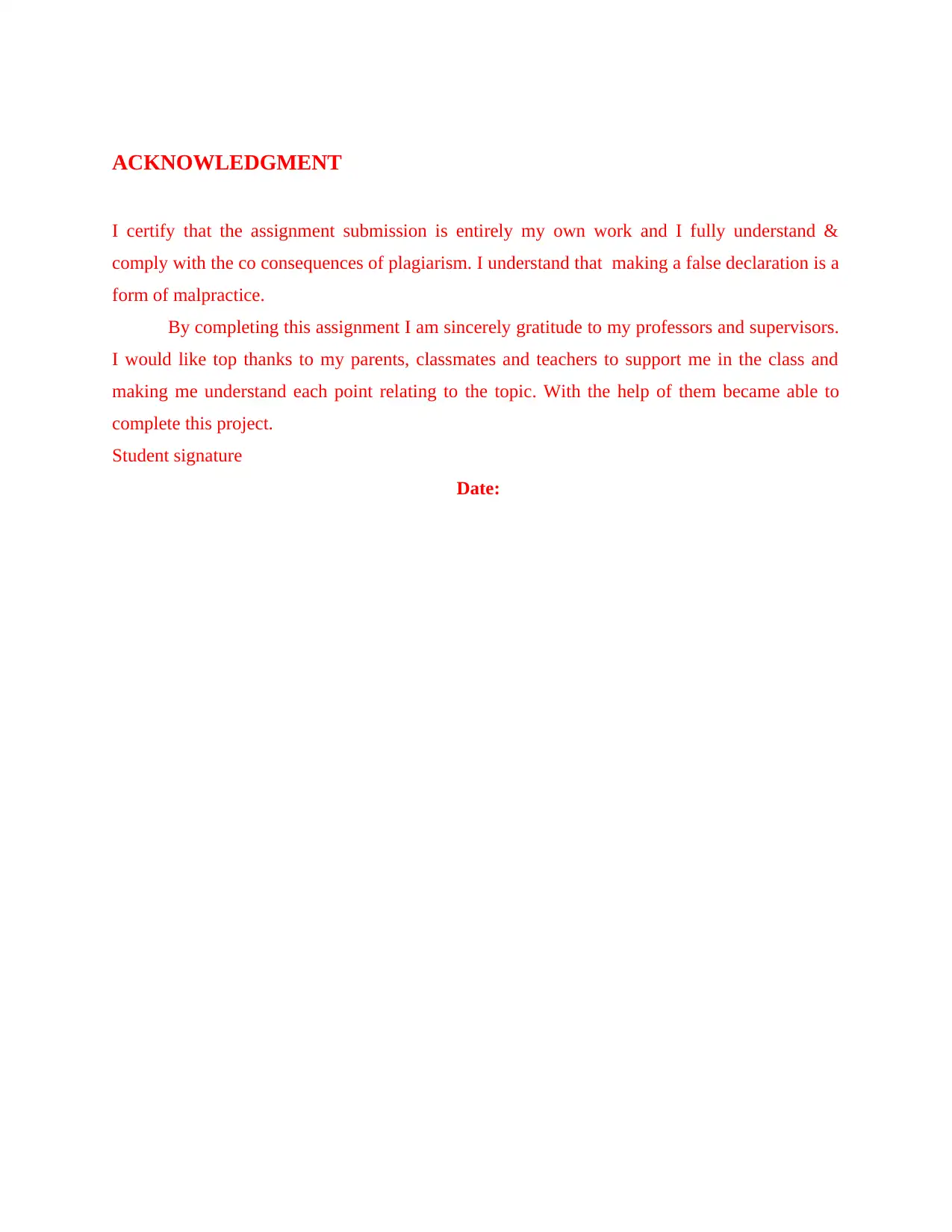
ACKNOWLEDGMENT
I certify that the assignment submission is entirely my own work and I fully understand &
comply with the co consequences of plagiarism. I understand that making a false declaration is a
form of malpractice.
By completing this assignment I am sincerely gratitude to my professors and supervisors.
I would like top thanks to my parents, classmates and teachers to support me in the class and
making me understand each point relating to the topic. With the help of them became able to
complete this project.
Student signature
Date:
I certify that the assignment submission is entirely my own work and I fully understand &
comply with the co consequences of plagiarism. I understand that making a false declaration is a
form of malpractice.
By completing this assignment I am sincerely gratitude to my professors and supervisors.
I would like top thanks to my parents, classmates and teachers to support me in the class and
making me understand each point relating to the topic. With the help of them became able to
complete this project.
Student signature
Date:
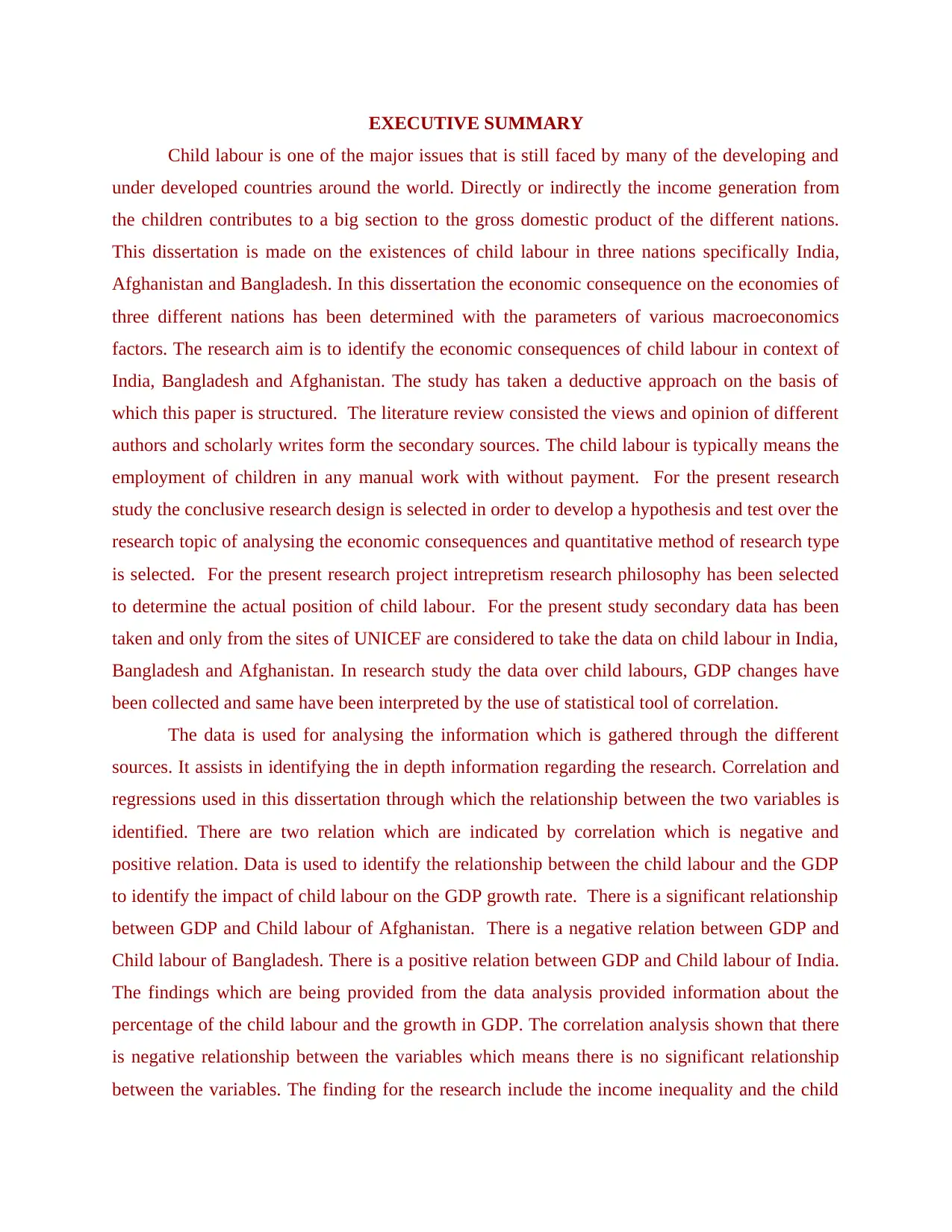
EXECUTIVE SUMMARY
Child labour is one of the major issues that is still faced by many of the developing and
under developed countries around the world. Directly or indirectly the income generation from
the children contributes to a big section to the gross domestic product of the different nations.
This dissertation is made on the existences of child labour in three nations specifically India,
Afghanistan and Bangladesh. In this dissertation the economic consequence on the economies of
three different nations has been determined with the parameters of various macroeconomics
factors. The research aim is to identify the economic consequences of child labour in context of
India, Bangladesh and Afghanistan. The study has taken a deductive approach on the basis of
which this paper is structured. The literature review consisted the views and opinion of different
authors and scholarly writes form the secondary sources. The child labour is typically means the
employment of children in any manual work with without payment. For the present research
study the conclusive research design is selected in order to develop a hypothesis and test over the
research topic of analysing the economic consequences and quantitative method of research type
is selected. For the present research project intrepretism research philosophy has been selected
to determine the actual position of child labour. For the present study secondary data has been
taken and only from the sites of UNICEF are considered to take the data on child labour in India,
Bangladesh and Afghanistan. In research study the data over child labours, GDP changes have
been collected and same have been interpreted by the use of statistical tool of correlation.
The data is used for analysing the information which is gathered through the different
sources. It assists in identifying the in depth information regarding the research. Correlation and
regressions used in this dissertation through which the relationship between the two variables is
identified. There are two relation which are indicated by correlation which is negative and
positive relation. Data is used to identify the relationship between the child labour and the GDP
to identify the impact of child labour on the GDP growth rate. There is a significant relationship
between GDP and Child labour of Afghanistan. There is a negative relation between GDP and
Child labour of Bangladesh. There is a positive relation between GDP and Child labour of India.
The findings which are being provided from the data analysis provided information about the
percentage of the child labour and the growth in GDP. The correlation analysis shown that there
is negative relationship between the variables which means there is no significant relationship
between the variables. The finding for the research include the income inequality and the child
Child labour is one of the major issues that is still faced by many of the developing and
under developed countries around the world. Directly or indirectly the income generation from
the children contributes to a big section to the gross domestic product of the different nations.
This dissertation is made on the existences of child labour in three nations specifically India,
Afghanistan and Bangladesh. In this dissertation the economic consequence on the economies of
three different nations has been determined with the parameters of various macroeconomics
factors. The research aim is to identify the economic consequences of child labour in context of
India, Bangladesh and Afghanistan. The study has taken a deductive approach on the basis of
which this paper is structured. The literature review consisted the views and opinion of different
authors and scholarly writes form the secondary sources. The child labour is typically means the
employment of children in any manual work with without payment. For the present research
study the conclusive research design is selected in order to develop a hypothesis and test over the
research topic of analysing the economic consequences and quantitative method of research type
is selected. For the present research project intrepretism research philosophy has been selected
to determine the actual position of child labour. For the present study secondary data has been
taken and only from the sites of UNICEF are considered to take the data on child labour in India,
Bangladesh and Afghanistan. In research study the data over child labours, GDP changes have
been collected and same have been interpreted by the use of statistical tool of correlation.
The data is used for analysing the information which is gathered through the different
sources. It assists in identifying the in depth information regarding the research. Correlation and
regressions used in this dissertation through which the relationship between the two variables is
identified. There are two relation which are indicated by correlation which is negative and
positive relation. Data is used to identify the relationship between the child labour and the GDP
to identify the impact of child labour on the GDP growth rate. There is a significant relationship
between GDP and Child labour of Afghanistan. There is a negative relation between GDP and
Child labour of Bangladesh. There is a positive relation between GDP and Child labour of India.
The findings which are being provided from the data analysis provided information about the
percentage of the child labour and the growth in GDP. The correlation analysis shown that there
is negative relationship between the variables which means there is no significant relationship
between the variables. The finding for the research include the income inequality and the child
⊘ This is a preview!⊘
Do you want full access?
Subscribe today to unlock all pages.

Trusted by 1+ million students worldwide
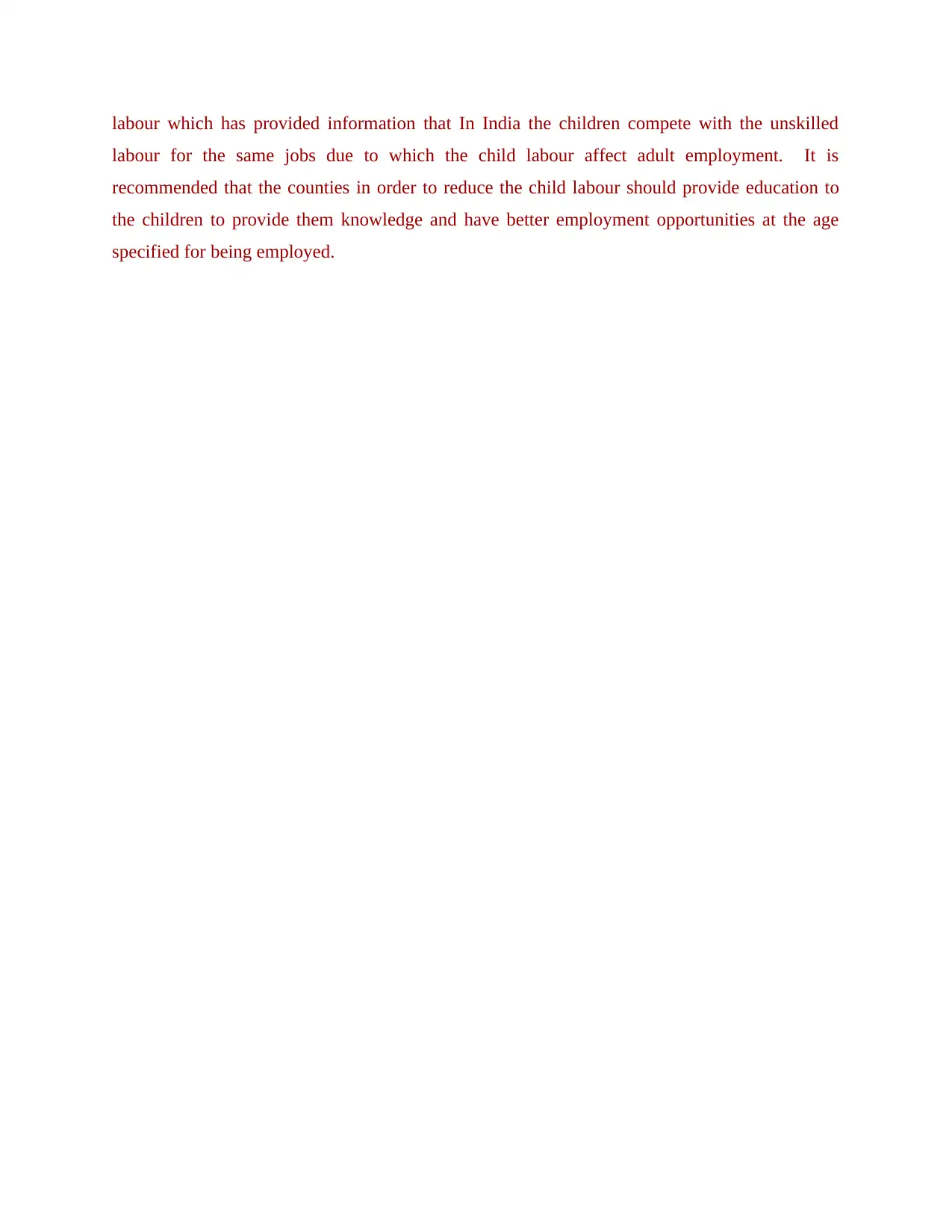
labour which has provided information that In India the children compete with the unskilled
labour for the same jobs due to which the child labour affect adult employment. It is
recommended that the counties in order to reduce the child labour should provide education to
the children to provide them knowledge and have better employment opportunities at the age
specified for being employed.
labour for the same jobs due to which the child labour affect adult employment. It is
recommended that the counties in order to reduce the child labour should provide education to
the children to provide them knowledge and have better employment opportunities at the age
specified for being employed.
Paraphrase This Document
Need a fresh take? Get an instant paraphrase of this document with our AI Paraphraser
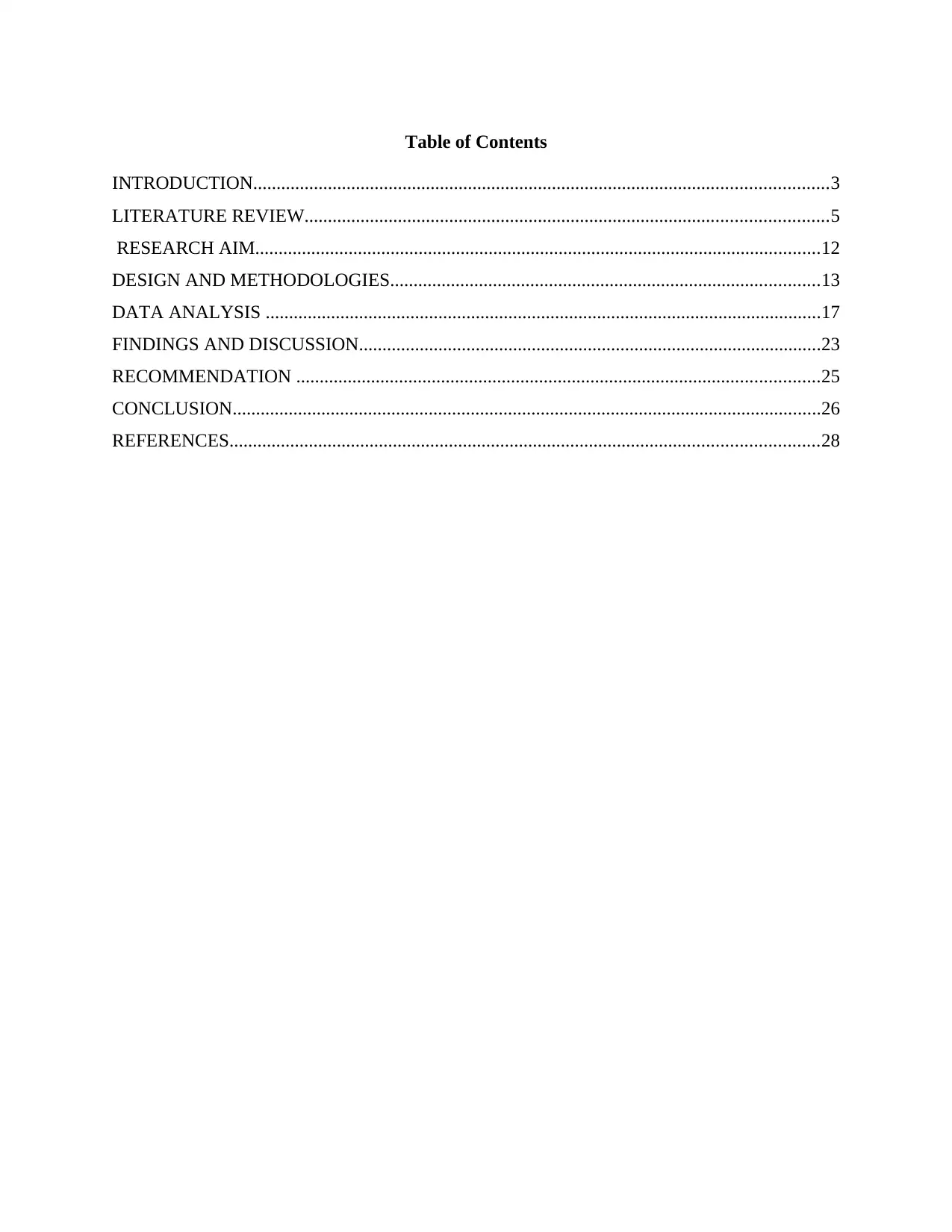
Table of Contents
INTRODUCTION...........................................................................................................................3
LITERATURE REVIEW................................................................................................................5
RESEARCH AIM.........................................................................................................................12
DESIGN AND METHODOLOGIES............................................................................................13
DATA ANALYSIS .......................................................................................................................17
FINDINGS AND DISCUSSION...................................................................................................23
RECOMMENDATION ................................................................................................................25
CONCLUSION..............................................................................................................................26
REFERENCES..............................................................................................................................28
INTRODUCTION...........................................................................................................................3
LITERATURE REVIEW................................................................................................................5
RESEARCH AIM.........................................................................................................................12
DESIGN AND METHODOLOGIES............................................................................................13
DATA ANALYSIS .......................................................................................................................17
FINDINGS AND DISCUSSION...................................................................................................23
RECOMMENDATION ................................................................................................................25
CONCLUSION..............................................................................................................................26
REFERENCES..............................................................................................................................28
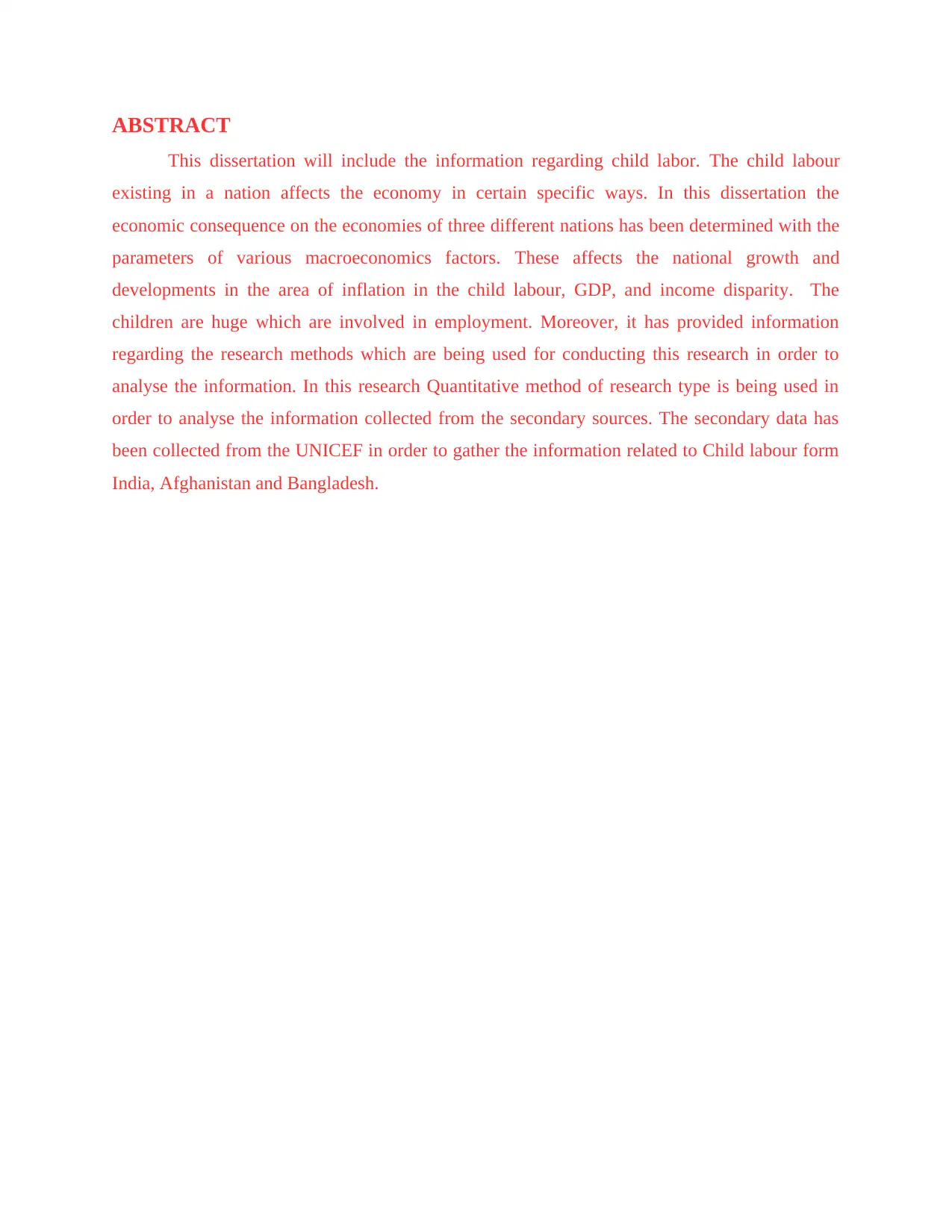
ABSTRACT
This dissertation will include the information regarding child labor. The child labour
existing in a nation affects the economy in certain specific ways. In this dissertation the
economic consequence on the economies of three different nations has been determined with the
parameters of various macroeconomics factors. These affects the national growth and
developments in the area of inflation in the child labour, GDP, and income disparity. The
children are huge which are involved in employment. Moreover, it has provided information
regarding the research methods which are being used for conducting this research in order to
analyse the information. In this research Quantitative method of research type is being used in
order to analyse the information collected from the secondary sources. The secondary data has
been collected from the UNICEF in order to gather the information related to Child labour form
India, Afghanistan and Bangladesh.
This dissertation will include the information regarding child labor. The child labour
existing in a nation affects the economy in certain specific ways. In this dissertation the
economic consequence on the economies of three different nations has been determined with the
parameters of various macroeconomics factors. These affects the national growth and
developments in the area of inflation in the child labour, GDP, and income disparity. The
children are huge which are involved in employment. Moreover, it has provided information
regarding the research methods which are being used for conducting this research in order to
analyse the information. In this research Quantitative method of research type is being used in
order to analyse the information collected from the secondary sources. The secondary data has
been collected from the UNICEF in order to gather the information related to Child labour form
India, Afghanistan and Bangladesh.
⊘ This is a preview!⊘
Do you want full access?
Subscribe today to unlock all pages.

Trusted by 1+ million students worldwide
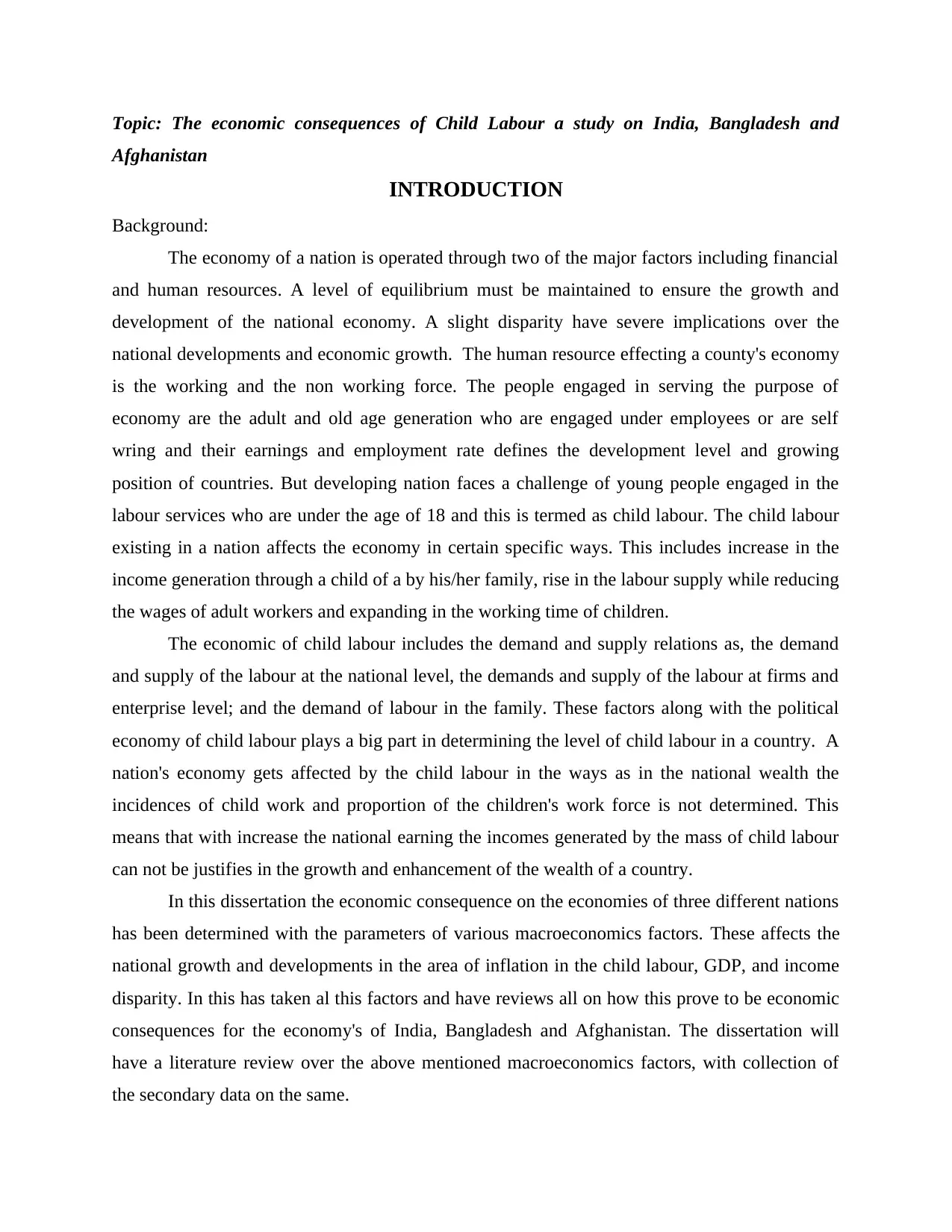
Topic: The economic consequences of Child Labour a study on India, Bangladesh and
Afghanistan
INTRODUCTION
Background:
The economy of a nation is operated through two of the major factors including financial
and human resources. A level of equilibrium must be maintained to ensure the growth and
development of the national economy. A slight disparity have severe implications over the
national developments and economic growth. The human resource effecting a county's economy
is the working and the non working force. The people engaged in serving the purpose of
economy are the adult and old age generation who are engaged under employees or are self
wring and their earnings and employment rate defines the development level and growing
position of countries. But developing nation faces a challenge of young people engaged in the
labour services who are under the age of 18 and this is termed as child labour. The child labour
existing in a nation affects the economy in certain specific ways. This includes increase in the
income generation through a child of a by his/her family, rise in the labour supply while reducing
the wages of adult workers and expanding in the working time of children.
The economic of child labour includes the demand and supply relations as, the demand
and supply of the labour at the national level, the demands and supply of the labour at firms and
enterprise level; and the demand of labour in the family. These factors along with the political
economy of child labour plays a big part in determining the level of child labour in a country. A
nation's economy gets affected by the child labour in the ways as in the national wealth the
incidences of child work and proportion of the children's work force is not determined. This
means that with increase the national earning the incomes generated by the mass of child labour
can not be justifies in the growth and enhancement of the wealth of a country.
In this dissertation the economic consequence on the economies of three different nations
has been determined with the parameters of various macroeconomics factors. These affects the
national growth and developments in the area of inflation in the child labour, GDP, and income
disparity. In this has taken al this factors and have reviews all on how this prove to be economic
consequences for the economy's of India, Bangladesh and Afghanistan. The dissertation will
have a literature review over the above mentioned macroeconomics factors, with collection of
the secondary data on the same.
Afghanistan
INTRODUCTION
Background:
The economy of a nation is operated through two of the major factors including financial
and human resources. A level of equilibrium must be maintained to ensure the growth and
development of the national economy. A slight disparity have severe implications over the
national developments and economic growth. The human resource effecting a county's economy
is the working and the non working force. The people engaged in serving the purpose of
economy are the adult and old age generation who are engaged under employees or are self
wring and their earnings and employment rate defines the development level and growing
position of countries. But developing nation faces a challenge of young people engaged in the
labour services who are under the age of 18 and this is termed as child labour. The child labour
existing in a nation affects the economy in certain specific ways. This includes increase in the
income generation through a child of a by his/her family, rise in the labour supply while reducing
the wages of adult workers and expanding in the working time of children.
The economic of child labour includes the demand and supply relations as, the demand
and supply of the labour at the national level, the demands and supply of the labour at firms and
enterprise level; and the demand of labour in the family. These factors along with the political
economy of child labour plays a big part in determining the level of child labour in a country. A
nation's economy gets affected by the child labour in the ways as in the national wealth the
incidences of child work and proportion of the children's work force is not determined. This
means that with increase the national earning the incomes generated by the mass of child labour
can not be justifies in the growth and enhancement of the wealth of a country.
In this dissertation the economic consequence on the economies of three different nations
has been determined with the parameters of various macroeconomics factors. These affects the
national growth and developments in the area of inflation in the child labour, GDP, and income
disparity. In this has taken al this factors and have reviews all on how this prove to be economic
consequences for the economy's of India, Bangladesh and Afghanistan. The dissertation will
have a literature review over the above mentioned macroeconomics factors, with collection of
the secondary data on the same.
Paraphrase This Document
Need a fresh take? Get an instant paraphrase of this document with our AI Paraphraser
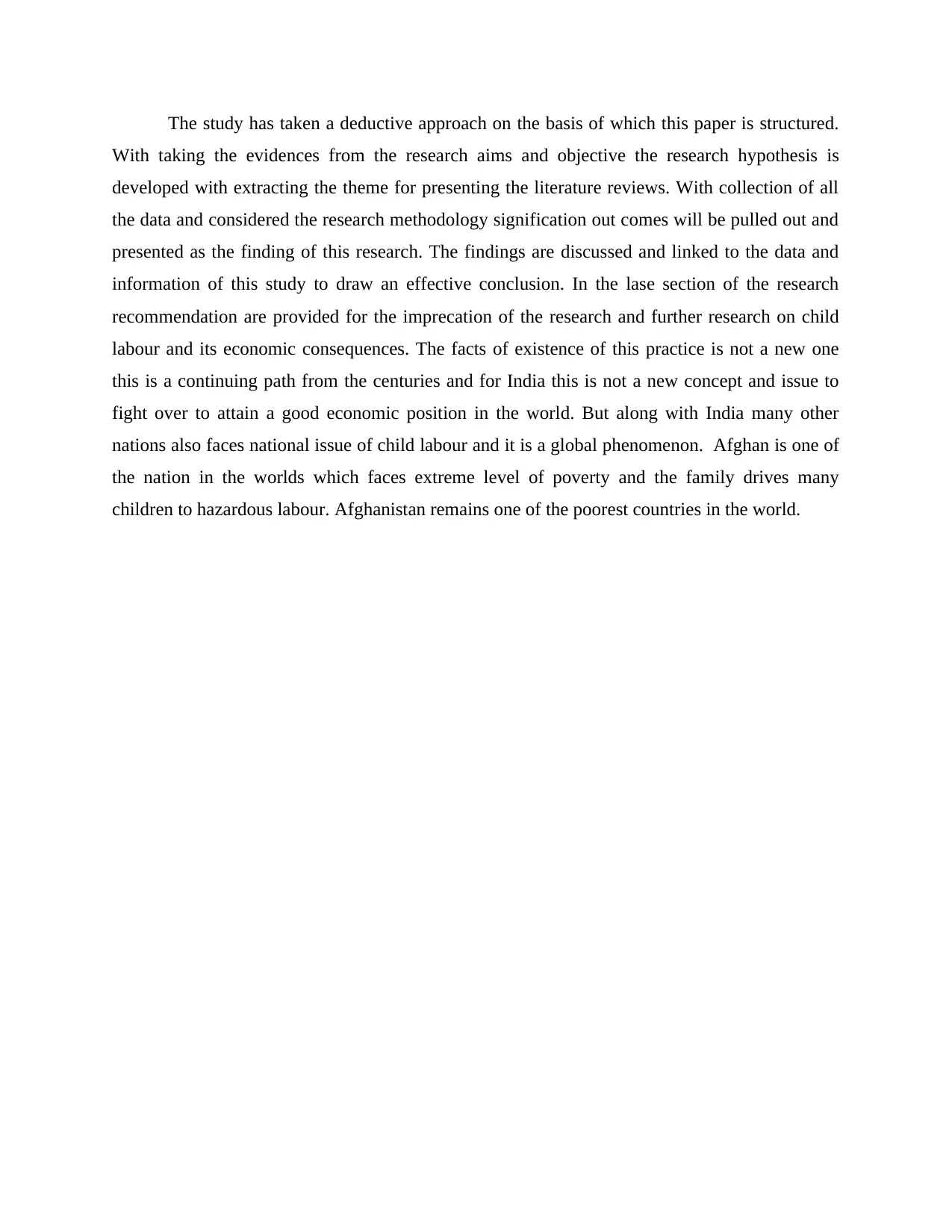
The study has taken a deductive approach on the basis of which this paper is structured.
With taking the evidences from the research aims and objective the research hypothesis is
developed with extracting the theme for presenting the literature reviews. With collection of all
the data and considered the research methodology signification out comes will be pulled out and
presented as the finding of this research. The findings are discussed and linked to the data and
information of this study to draw an effective conclusion. In the lase section of the research
recommendation are provided for the imprecation of the research and further research on child
labour and its economic consequences. The facts of existence of this practice is not a new one
this is a continuing path from the centuries and for India this is not a new concept and issue to
fight over to attain a good economic position in the world. But along with India many other
nations also faces national issue of child labour and it is a global phenomenon. Afghan is one of
the nation in the worlds which faces extreme level of poverty and the family drives many
children to hazardous labour. Afghanistan remains one of the poorest countries in the world.
With taking the evidences from the research aims and objective the research hypothesis is
developed with extracting the theme for presenting the literature reviews. With collection of all
the data and considered the research methodology signification out comes will be pulled out and
presented as the finding of this research. The findings are discussed and linked to the data and
information of this study to draw an effective conclusion. In the lase section of the research
recommendation are provided for the imprecation of the research and further research on child
labour and its economic consequences. The facts of existence of this practice is not a new one
this is a continuing path from the centuries and for India this is not a new concept and issue to
fight over to attain a good economic position in the world. But along with India many other
nations also faces national issue of child labour and it is a global phenomenon. Afghan is one of
the nation in the worlds which faces extreme level of poverty and the family drives many
children to hazardous labour. Afghanistan remains one of the poorest countries in the world.
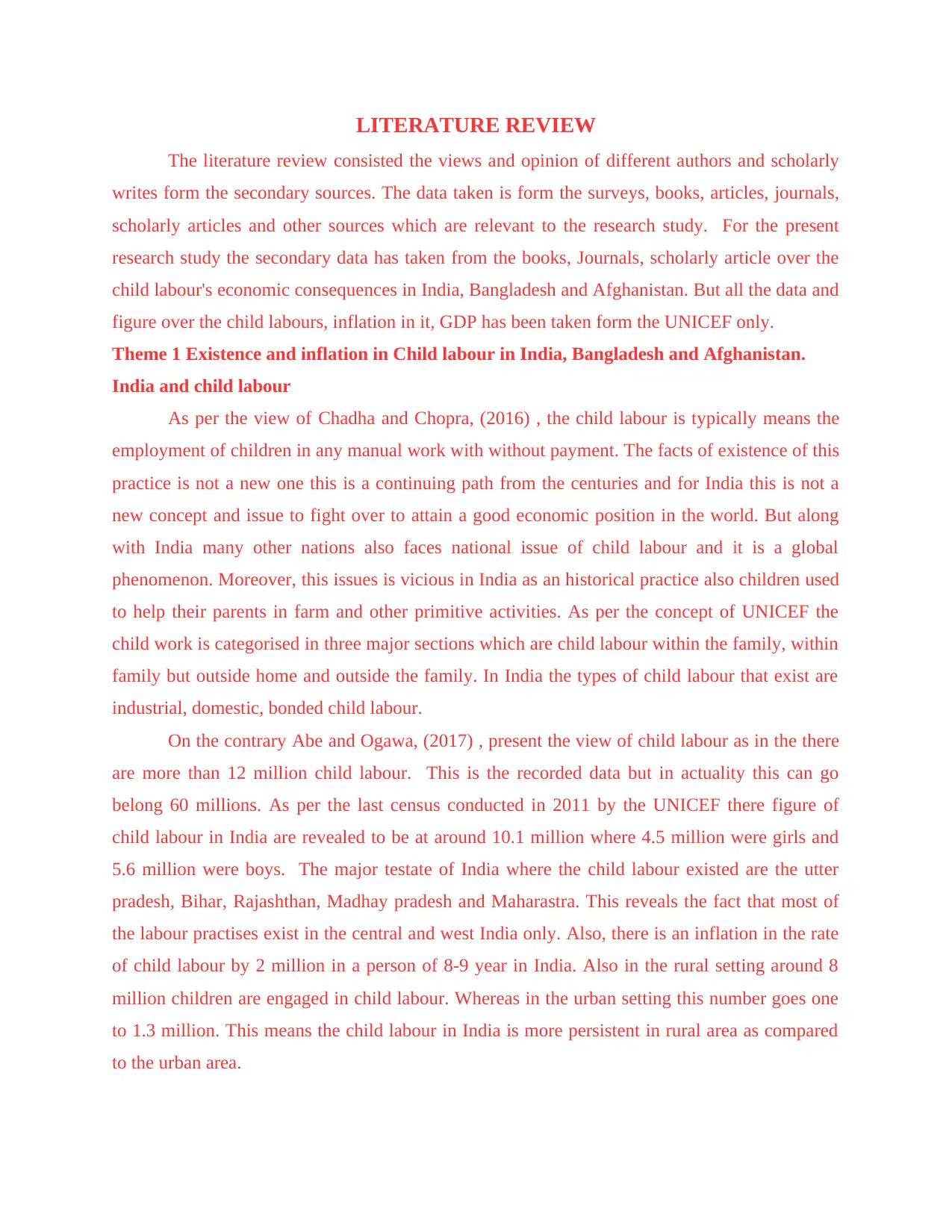
LITERATURE REVIEW
The literature review consisted the views and opinion of different authors and scholarly
writes form the secondary sources. The data taken is form the surveys, books, articles, journals,
scholarly articles and other sources which are relevant to the research study. For the present
research study the secondary data has taken from the books, Journals, scholarly article over the
child labour's economic consequences in India, Bangladesh and Afghanistan. But all the data and
figure over the child labours, inflation in it, GDP has been taken form the UNICEF only.
Theme 1 Existence and inflation in Child labour in India, Bangladesh and Afghanistan.
India and child labour
As per the view of Chadha and Chopra, (2016) , the child labour is typically means the
employment of children in any manual work with without payment. The facts of existence of this
practice is not a new one this is a continuing path from the centuries and for India this is not a
new concept and issue to fight over to attain a good economic position in the world. But along
with India many other nations also faces national issue of child labour and it is a global
phenomenon. Moreover, this issues is vicious in India as an historical practice also children used
to help their parents in farm and other primitive activities. As per the concept of UNICEF the
child work is categorised in three major sections which are child labour within the family, within
family but outside home and outside the family. In India the types of child labour that exist are
industrial, domestic, bonded child labour.
On the contrary Abe and Ogawa, (2017) , present the view of child labour as in the there
are more than 12 million child labour. This is the recorded data but in actuality this can go
belong 60 millions. As per the last census conducted in 2011 by the UNICEF there figure of
child labour in India are revealed to be at around 10.1 million where 4.5 million were girls and
5.6 million were boys. The major testate of India where the child labour existed are the utter
pradesh, Bihar, Rajashthan, Madhay pradesh and Maharastra. This reveals the fact that most of
the labour practises exist in the central and west India only. Also, there is an inflation in the rate
of child labour by 2 million in a person of 8-9 year in India. Also in the rural setting around 8
million children are engaged in child labour. Whereas in the urban setting this number goes one
to 1.3 million. This means the child labour in India is more persistent in rural area as compared
to the urban area.
The literature review consisted the views and opinion of different authors and scholarly
writes form the secondary sources. The data taken is form the surveys, books, articles, journals,
scholarly articles and other sources which are relevant to the research study. For the present
research study the secondary data has taken from the books, Journals, scholarly article over the
child labour's economic consequences in India, Bangladesh and Afghanistan. But all the data and
figure over the child labours, inflation in it, GDP has been taken form the UNICEF only.
Theme 1 Existence and inflation in Child labour in India, Bangladesh and Afghanistan.
India and child labour
As per the view of Chadha and Chopra, (2016) , the child labour is typically means the
employment of children in any manual work with without payment. The facts of existence of this
practice is not a new one this is a continuing path from the centuries and for India this is not a
new concept and issue to fight over to attain a good economic position in the world. But along
with India many other nations also faces national issue of child labour and it is a global
phenomenon. Moreover, this issues is vicious in India as an historical practice also children used
to help their parents in farm and other primitive activities. As per the concept of UNICEF the
child work is categorised in three major sections which are child labour within the family, within
family but outside home and outside the family. In India the types of child labour that exist are
industrial, domestic, bonded child labour.
On the contrary Abe and Ogawa, (2017) , present the view of child labour as in the there
are more than 12 million child labour. This is the recorded data but in actuality this can go
belong 60 millions. As per the last census conducted in 2011 by the UNICEF there figure of
child labour in India are revealed to be at around 10.1 million where 4.5 million were girls and
5.6 million were boys. The major testate of India where the child labour existed are the utter
pradesh, Bihar, Rajashthan, Madhay pradesh and Maharastra. This reveals the fact that most of
the labour practises exist in the central and west India only. Also, there is an inflation in the rate
of child labour by 2 million in a person of 8-9 year in India. Also in the rural setting around 8
million children are engaged in child labour. Whereas in the urban setting this number goes one
to 1.3 million. This means the child labour in India is more persistent in rural area as compared
to the urban area.
⊘ This is a preview!⊘
Do you want full access?
Subscribe today to unlock all pages.

Trusted by 1+ million students worldwide
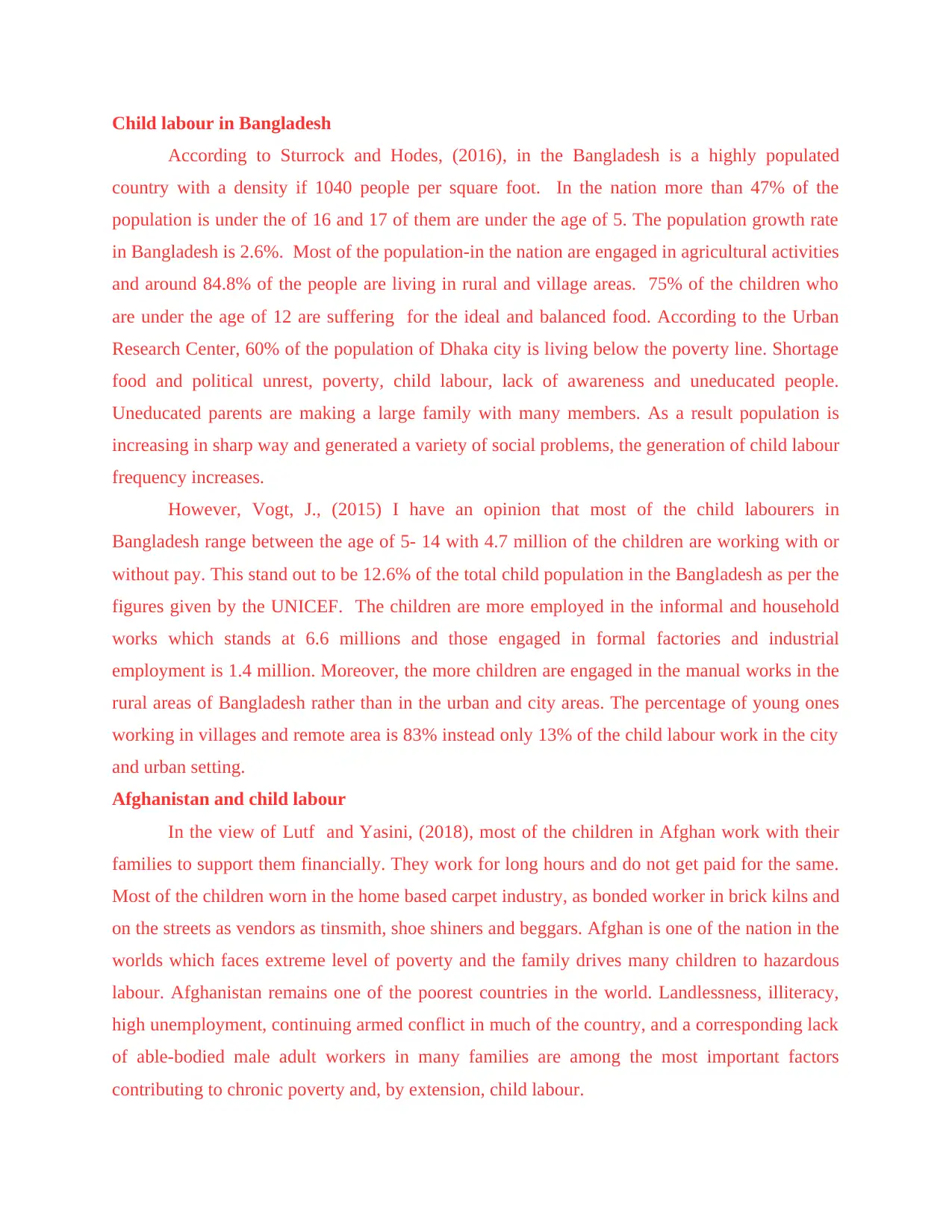
Child labour in Bangladesh
According to Sturrock and Hodes, (2016), in the Bangladesh is a highly populated
country with a density if 1040 people per square foot. In the nation more than 47% of the
population is under the of 16 and 17 of them are under the age of 5. The population growth rate
in Bangladesh is 2.6%. Most of the population-in the nation are engaged in agricultural activities
and around 84.8% of the people are living in rural and village areas. 75% of the children who
are under the age of 12 are suffering for the ideal and balanced food. According to the Urban
Research Center, 60% of the population of Dhaka city is living below the poverty line. Shortage
food and political unrest, poverty, child labour, lack of awareness and uneducated people.
Uneducated parents are making a large family with many members. As a result population is
increasing in sharp way and generated a variety of social problems, the generation of child labour
frequency increases.
However, Vogt, J., (2015) I have an opinion that most of the child labourers in
Bangladesh range between the age of 5- 14 with 4.7 million of the children are working with or
without pay. This stand out to be 12.6% of the total child population in the Bangladesh as per the
figures given by the UNICEF. The children are more employed in the informal and household
works which stands at 6.6 millions and those engaged in formal factories and industrial
employment is 1.4 million. Moreover, the more children are engaged in the manual works in the
rural areas of Bangladesh rather than in the urban and city areas. The percentage of young ones
working in villages and remote area is 83% instead only 13% of the child labour work in the city
and urban setting.
Afghanistan and child labour
In the view of Lutf and Yasini, (2018), most of the children in Afghan work with their
families to support them financially. They work for long hours and do not get paid for the same.
Most of the children worn in the home based carpet industry, as bonded worker in brick kilns and
on the streets as vendors as tinsmith, shoe shiners and beggars. Afghan is one of the nation in the
worlds which faces extreme level of poverty and the family drives many children to hazardous
labour. Afghanistan remains one of the poorest countries in the world. Landlessness, illiteracy,
high unemployment, continuing armed conflict in much of the country, and a corresponding lack
of able-bodied male adult workers in many families are among the most important factors
contributing to chronic poverty and, by extension, child labour.
According to Sturrock and Hodes, (2016), in the Bangladesh is a highly populated
country with a density if 1040 people per square foot. In the nation more than 47% of the
population is under the of 16 and 17 of them are under the age of 5. The population growth rate
in Bangladesh is 2.6%. Most of the population-in the nation are engaged in agricultural activities
and around 84.8% of the people are living in rural and village areas. 75% of the children who
are under the age of 12 are suffering for the ideal and balanced food. According to the Urban
Research Center, 60% of the population of Dhaka city is living below the poverty line. Shortage
food and political unrest, poverty, child labour, lack of awareness and uneducated people.
Uneducated parents are making a large family with many members. As a result population is
increasing in sharp way and generated a variety of social problems, the generation of child labour
frequency increases.
However, Vogt, J., (2015) I have an opinion that most of the child labourers in
Bangladesh range between the age of 5- 14 with 4.7 million of the children are working with or
without pay. This stand out to be 12.6% of the total child population in the Bangladesh as per the
figures given by the UNICEF. The children are more employed in the informal and household
works which stands at 6.6 millions and those engaged in formal factories and industrial
employment is 1.4 million. Moreover, the more children are engaged in the manual works in the
rural areas of Bangladesh rather than in the urban and city areas. The percentage of young ones
working in villages and remote area is 83% instead only 13% of the child labour work in the city
and urban setting.
Afghanistan and child labour
In the view of Lutf and Yasini, (2018), most of the children in Afghan work with their
families to support them financially. They work for long hours and do not get paid for the same.
Most of the children worn in the home based carpet industry, as bonded worker in brick kilns and
on the streets as vendors as tinsmith, shoe shiners and beggars. Afghan is one of the nation in the
worlds which faces extreme level of poverty and the family drives many children to hazardous
labour. Afghanistan remains one of the poorest countries in the world. Landlessness, illiteracy,
high unemployment, continuing armed conflict in much of the country, and a corresponding lack
of able-bodied male adult workers in many families are among the most important factors
contributing to chronic poverty and, by extension, child labour.
Paraphrase This Document
Need a fresh take? Get an instant paraphrase of this document with our AI Paraphraser
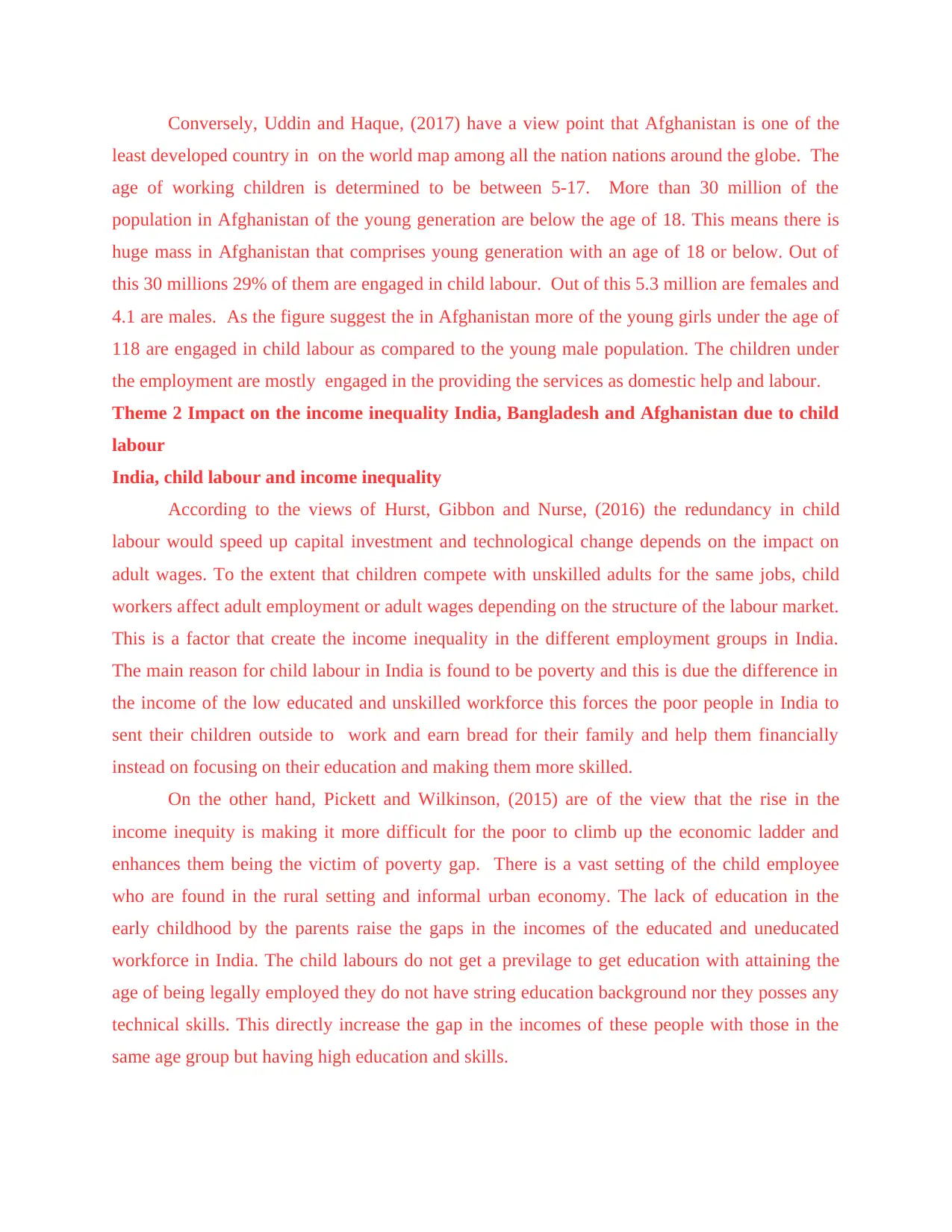
Conversely, Uddin and Haque, (2017) have a view point that Afghanistan is one of the
least developed country in on the world map among all the nation nations around the globe. The
age of working children is determined to be between 5-17. More than 30 million of the
population in Afghanistan of the young generation are below the age of 18. This means there is
huge mass in Afghanistan that comprises young generation with an age of 18 or below. Out of
this 30 millions 29% of them are engaged in child labour. Out of this 5.3 million are females and
4.1 are males. As the figure suggest the in Afghanistan more of the young girls under the age of
118 are engaged in child labour as compared to the young male population. The children under
the employment are mostly engaged in the providing the services as domestic help and labour.
Theme 2 Impact on the income inequality India, Bangladesh and Afghanistan due to child
labour
India, child labour and income inequality
According to the views of Hurst, Gibbon and Nurse, (2016) the redundancy in child
labour would speed up capital investment and technological change depends on the impact on
adult wages. To the extent that children compete with unskilled adults for the same jobs, child
workers affect adult employment or adult wages depending on the structure of the labour market.
This is a factor that create the income inequality in the different employment groups in India.
The main reason for child labour in India is found to be poverty and this is due the difference in
the income of the low educated and unskilled workforce this forces the poor people in India to
sent their children outside to work and earn bread for their family and help them financially
instead on focusing on their education and making them more skilled.
On the other hand, Pickett and Wilkinson, (2015) are of the view that the rise in the
income inequity is making it more difficult for the poor to climb up the economic ladder and
enhances them being the victim of poverty gap. There is a vast setting of the child employee
who are found in the rural setting and informal urban economy. The lack of education in the
early childhood by the parents raise the gaps in the incomes of the educated and uneducated
workforce in India. The child labours do not get a previlage to get education with attaining the
age of being legally employed they do not have string education background nor they posses any
technical skills. This directly increase the gap in the incomes of these people with those in the
same age group but having high education and skills.
least developed country in on the world map among all the nation nations around the globe. The
age of working children is determined to be between 5-17. More than 30 million of the
population in Afghanistan of the young generation are below the age of 18. This means there is
huge mass in Afghanistan that comprises young generation with an age of 18 or below. Out of
this 30 millions 29% of them are engaged in child labour. Out of this 5.3 million are females and
4.1 are males. As the figure suggest the in Afghanistan more of the young girls under the age of
118 are engaged in child labour as compared to the young male population. The children under
the employment are mostly engaged in the providing the services as domestic help and labour.
Theme 2 Impact on the income inequality India, Bangladesh and Afghanistan due to child
labour
India, child labour and income inequality
According to the views of Hurst, Gibbon and Nurse, (2016) the redundancy in child
labour would speed up capital investment and technological change depends on the impact on
adult wages. To the extent that children compete with unskilled adults for the same jobs, child
workers affect adult employment or adult wages depending on the structure of the labour market.
This is a factor that create the income inequality in the different employment groups in India.
The main reason for child labour in India is found to be poverty and this is due the difference in
the income of the low educated and unskilled workforce this forces the poor people in India to
sent their children outside to work and earn bread for their family and help them financially
instead on focusing on their education and making them more skilled.
On the other hand, Pickett and Wilkinson, (2015) are of the view that the rise in the
income inequity is making it more difficult for the poor to climb up the economic ladder and
enhances them being the victim of poverty gap. There is a vast setting of the child employee
who are found in the rural setting and informal urban economy. The lack of education in the
early childhood by the parents raise the gaps in the incomes of the educated and uneducated
workforce in India. The child labours do not get a previlage to get education with attaining the
age of being legally employed they do not have string education background nor they posses any
technical skills. This directly increase the gap in the incomes of these people with those in the
same age group but having high education and skills.
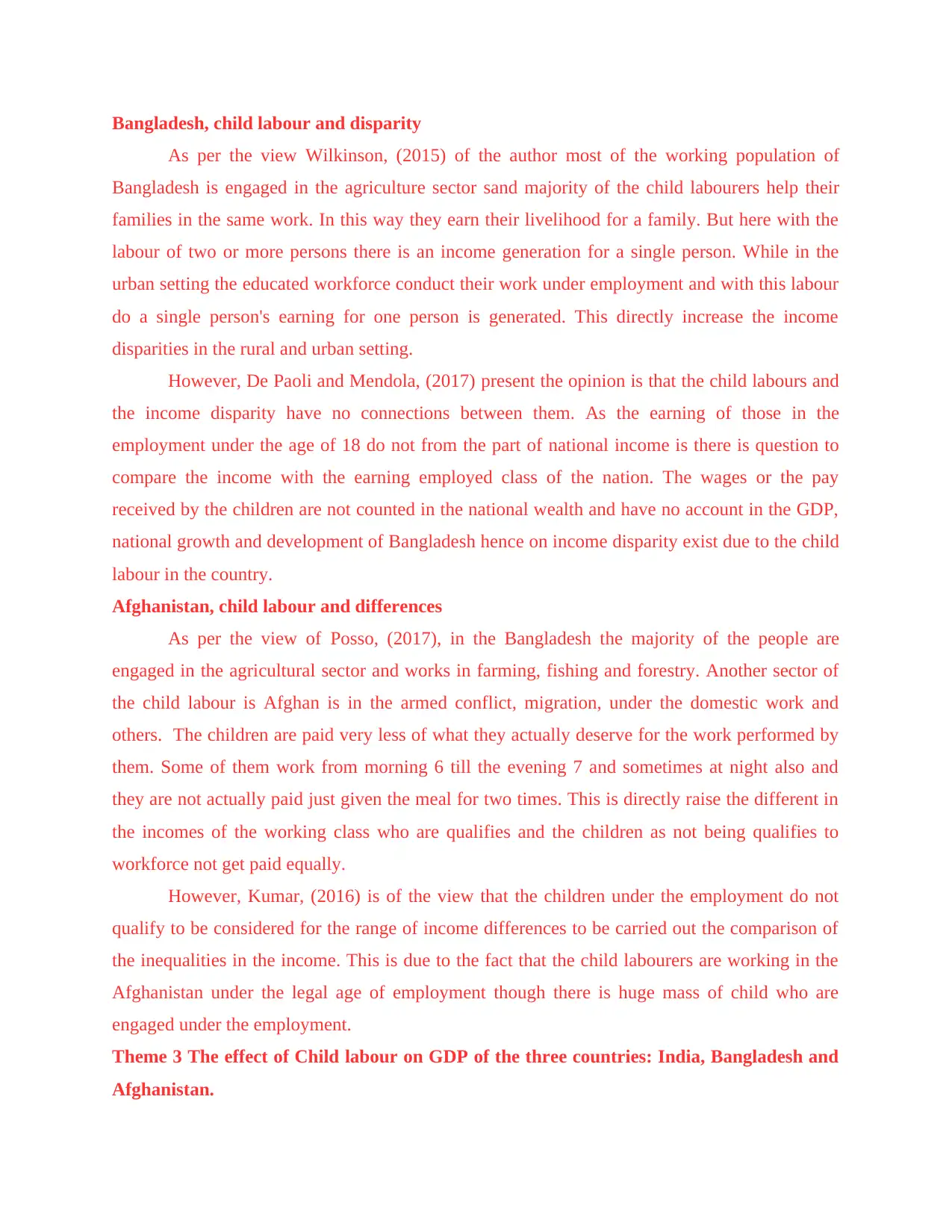
Bangladesh, child labour and disparity
As per the view Wilkinson, (2015) of the author most of the working population of
Bangladesh is engaged in the agriculture sector sand majority of the child labourers help their
families in the same work. In this way they earn their livelihood for a family. But here with the
labour of two or more persons there is an income generation for a single person. While in the
urban setting the educated workforce conduct their work under employment and with this labour
do a single person's earning for one person is generated. This directly increase the income
disparities in the rural and urban setting.
However, De Paoli and Mendola, (2017) present the opinion is that the child labours and
the income disparity have no connections between them. As the earning of those in the
employment under the age of 18 do not from the part of national income is there is question to
compare the income with the earning employed class of the nation. The wages or the pay
received by the children are not counted in the national wealth and have no account in the GDP,
national growth and development of Bangladesh hence on income disparity exist due to the child
labour in the country.
Afghanistan, child labour and differences
As per the view of Posso, (2017), in the Bangladesh the majority of the people are
engaged in the agricultural sector and works in farming, fishing and forestry. Another sector of
the child labour is Afghan is in the armed conflict, migration, under the domestic work and
others. The children are paid very less of what they actually deserve for the work performed by
them. Some of them work from morning 6 till the evening 7 and sometimes at night also and
they are not actually paid just given the meal for two times. This is directly raise the different in
the incomes of the working class who are qualifies and the children as not being qualifies to
workforce not get paid equally.
However, Kumar, (2016) is of the view that the children under the employment do not
qualify to be considered for the range of income differences to be carried out the comparison of
the inequalities in the income. This is due to the fact that the child labourers are working in the
Afghanistan under the legal age of employment though there is huge mass of child who are
engaged under the employment.
Theme 3 The effect of Child labour on GDP of the three countries: India, Bangladesh and
Afghanistan.
As per the view Wilkinson, (2015) of the author most of the working population of
Bangladesh is engaged in the agriculture sector sand majority of the child labourers help their
families in the same work. In this way they earn their livelihood for a family. But here with the
labour of two or more persons there is an income generation for a single person. While in the
urban setting the educated workforce conduct their work under employment and with this labour
do a single person's earning for one person is generated. This directly increase the income
disparities in the rural and urban setting.
However, De Paoli and Mendola, (2017) present the opinion is that the child labours and
the income disparity have no connections between them. As the earning of those in the
employment under the age of 18 do not from the part of national income is there is question to
compare the income with the earning employed class of the nation. The wages or the pay
received by the children are not counted in the national wealth and have no account in the GDP,
national growth and development of Bangladesh hence on income disparity exist due to the child
labour in the country.
Afghanistan, child labour and differences
As per the view of Posso, (2017), in the Bangladesh the majority of the people are
engaged in the agricultural sector and works in farming, fishing and forestry. Another sector of
the child labour is Afghan is in the armed conflict, migration, under the domestic work and
others. The children are paid very less of what they actually deserve for the work performed by
them. Some of them work from morning 6 till the evening 7 and sometimes at night also and
they are not actually paid just given the meal for two times. This is directly raise the different in
the incomes of the working class who are qualifies and the children as not being qualifies to
workforce not get paid equally.
However, Kumar, (2016) is of the view that the children under the employment do not
qualify to be considered for the range of income differences to be carried out the comparison of
the inequalities in the income. This is due to the fact that the child labourers are working in the
Afghanistan under the legal age of employment though there is huge mass of child who are
engaged under the employment.
Theme 3 The effect of Child labour on GDP of the three countries: India, Bangladesh and
Afghanistan.
⊘ This is a preview!⊘
Do you want full access?
Subscribe today to unlock all pages.

Trusted by 1+ million students worldwide
1 out of 31
Related Documents
Your All-in-One AI-Powered Toolkit for Academic Success.
+13062052269
info@desklib.com
Available 24*7 on WhatsApp / Email
![[object Object]](/_next/static/media/star-bottom.7253800d.svg)
Unlock your academic potential
Copyright © 2020–2025 A2Z Services. All Rights Reserved. Developed and managed by ZUCOL.




